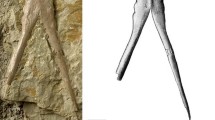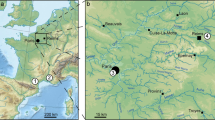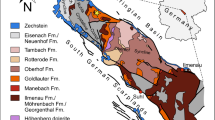Abstract
The postcranial morphology of Nothosaurus from Winterswijk is described on the basis of three partially preserved skeletons. Because of the association with a diagnostic cranium, two of these can be confidently assigned to N. marchicus. Preserved humeri are recognized as morphotype II, which confirms the relationship between this humeral morphotype and N. marchicus. The occurrence of an additional nothosaur taxon in the Lower Muschelkalk, strong sexual dimorphism, or a broader size range of N. marchicus is evidenced again. The postcranial morphology of Nothosaurus is compared to published and new data on the basal pistosauroid (cf. Cymatosaurus) from the same locality. Numerous shared morphological characters of N. marchicus, Nothosaurus sp., and the basal pistosauroid from Winterswijk hamper assignment of isolated bones, which is presently only possible if a combination of features on multiple bones from a single individual can be assessed. Ontogenetic stage of the described skeletons is discussed as well. Differences between N. marchicus, the basal pistosauroid, and the morphologically similar, but smaller pachypleurosaur A. heterodontus are mainly related to the morphologies of the humerus, ulna, and the clavicle-interclavicle complex, and thereby indicate different modes of locomotion i.e., swimming styles. The pachypleurosaur and the basal pistosauroid were most likely anguilliform swimmers, whereas Nothosaurus also employed its forelimbs during swimming (paraxial swimming). Taphonomical observations on material of the Winterswijk locality indicate the presence of scavengers, although most disarticulated skeletons were transported by water and decayed and disintegrated in shallow water.
Kurzfassung
Die Morphologie des postcranial Skelettes von Nothosaurus wird anhand dreier unvollständig erhaltener Skelette von der Fundstelle Winterswijk beschrieben. Zwei der Skelettreste wurden mit diagnostischem Schädelmaterial gefunden und können so unzweifelhaft N. marchicus zugeordnet werden. Soweit erhalten, können die Humeri dem Nothosaurus-Morphotyp II zugeschrieben werden, was die bereits zuvor gezogene Verbindung dieses Humerus Morphotyps mit diesem Taxon bestätigt. Auch mit dieser Studie wird auf das Vorkommen eines weiteren Nothosaurus Taxons im unteren Muschelkalk, oder einen deutlichen geschlechtlichen Dimorphismus, oder aber auf ein breiteres Größenspektrum für N. marchicus hingewiesen. Postcraniale Elemente von Nothosaurus werden mit der Morphologie des basalen Pistosauroiden (cf. Cymatosaurus) anhand publizierter Daten aber auch anhand von Neufunden aus Winterswijk verglichen. Zahlreichen morphologischen Ähnlichkeiten stehen einige wenige Unterschiede gegenüber was die Zuordnung isolierter Knochen (Einzelfunden) erschwert oder gar unmöglich macht. Nur die Kombination von Merkmalen unterschiedlicher Knochen eines Individuums ermöglicht eine genauere taxonomische Zuordnung. Des weiteren wird das ontogenetische Alter der Skelette diskutiert. Morphologische Unterschiede zwischen Nothosaurus, dem basalen Pistosauroiden und dem morphologisch ebenfalls ähnlichen, obwohl kleineren Pachypleurosaurier A. heterodontus betreffen vor allem den Humerus, die Ulna und den Clavicula-Interclavicula-Komplex, was auf Unterschiede in der Lokomotion, also im Schwimmstil, hindeutet. Der Pachypleurosaurier A. heterodontus und der basale Pistosauroide waren höchstwahrscheinlich anguilliforme Schwimmer, wohingegen Nothosaurus bereits seine Vorderarme zur Fortbewegung nutzte was auf paraxiales Schwimmen deutet. Taphonomische Beobachtungen an den Skeletten von marinen Reptilien aus der Fundstelle Winterswijk beweisen die Anwesenheit von Aasfressern. Die meisten Skelette wurden jedoch im Wasser transportiert und zerfielen dann langsam im Flachwasser, wo sie schließlich in unterschiedlicher Erhaltung eingebettet wurden.





Similar content being viewed by others
References
Aigner, T. 1985. Storm depositional systems: Dynamic stratigraphy in modern and ancient shallow-marine sequences, 174. Berlin: Springer-Verlag.
Albers, P.C.H. 2005. A placodontoid jaw fragment from the Lower Muschelkalk of Winterswijk (The Netherlands). PalArch’s Journal Of Vertebrate Palaeontology 3: 33–36. http://www.palarch.nl/2005/07/albers2005/.
Albers, P.C.H. 2011. New Nothosaurus skulls from the Lower Muschelkalk of the western Lower Saxony Basin (Winterswijk, The Netherlands) shed new light on the status of Nothosaurus winterswijkensis. Netherlands Journal of Geosciences 90(1): 15–22.
Albers, P.C.H., and O. Rieppel. 2003. A new species of the sauropterygian genus Nothosaurus from the Lower Muschelkalk of Winterswijk, The Netherlands. Journal of Paleontology 77: 738–744.
Baur, G. 1889. Palaeohatteria Credner, and the Proganosauria. American Journal of Science 37: 310–313.
Bickelmann, C., and P.M. Sander. 2008. A partial skeleton and isolated humeri of Nothosaurus (Reptilia: Eosauropterygia) from Winterswijk, The Netherlands. Journal of Vertebrate Paleontology 28: 326–338.
Brochu, C.A. 1996. Closure of neurocentral sutures during crocodilian ontogeny: implications for maturity assessment in fossil archosaurs. Journal of Vertebrate Paleontology 16: 49–62.
Caroll, R.L. 1985. Evolutionary constraints in aquatic diapsid reptiles. Special Papers in Palaeontology 33: 145–155.
Castanet, J., H. Francillon-Vieillot, F.J. Meunier, and A. de Ricqlés. 1993. Bone and individual aging. In Bone Growth, vol. 7, ed. B.K. Hall, 245–283. Boca Raton: CRC Press.
Dülfer, O., and N. Klein. 2006. Studentische Lehrgrabung im Winterswijker Muschelkalk. Der Präparator 52: 90–96.
Edinger, T. 1921. Über Nothosaurus. Unpublished Ph.D. dissertation, Frankfurt a.M: Johann-Wolfgang-Goethe University.
Gürich, G.J.E. 1884. Über einige Saurier des oberschlesischen Muschelkalkes. Zeitschrift der Deutschen Geologischen Gesellschaft 36: 125–144.
Haas, G. 1980. Ein Nothosaurier-Schädel aus dem Muschelkalk des Wadi Ramon (Negev, Israel). Annalen des Naturhistorischen Museums Wien 83: 119–125.
Hagdorn, H., and O. Rieppel. 1999. Stratigraphy of marine reptiles in the Triassic of Europe. Zentralblatt für Geologie und Paläontologie Teil I: 651–678.
Hagdorn, H. and Th. Simon. 2010. Vossenveld-Formation. Litholex (Lithostratigraphische Einheiten Deutschlands) ID 45: 1–6. http://www.bgr.de/app/litholex/gesamt_ausgabe_neu.php?id=45.
Herngreen, G.F.W., J.H.A. van Konijnenburg-van Cittert, and H.W. Oosterink. New geological data (Middle Triassic, Rhaetian-Liassic and Oligocene) of the Winterswijk quarry, the eastern Netherlands. Netherlands Journal of Geosciences 84-4: 409-413.
Hooijer, D.A. 1959. Records of nothosaurians from the Muschelkalk of Winterswijk, Netherlands. Geologie en Mijnbouw 2: 37–39.
Hugi, J. 2011. The long bone histology of Ceresiosaurus (Sauropterygia, Reptilia) in comparison to other eosauropterygians from the Middle Triassic of Monte San Giorgio (Switzerland/Italy). Swiss Journal of Palaeontology. doi:10.1007/s13358-011-0023-6.
Hugi, J., T.M. Scheyer, N. Klein, P.M. Sander, and M.R. Sànchez-Villagra. 2011. Long bone microstructure and life history data of pachypleurosaurids from the Middle Triassic of Monte San Giorgio, Switzerland/Italy. Comptes Rendus Palevol 10: 413–426.
Ji, C., D.-Y. Jiang, O. Rieppel, R. Motani, A. Tintori, and Z.-Y. Sun. 2014. A new specimen of Nothosaurus youngi from the Middle Triassic of Guizhou, China. Journal of Vertebrate Paleontology 34: 465–470.
Jiang, W., M.W. Maisch, W. Hao, Y. Sun, and Z. Sun. 2006. Nothosaurus yangjuanensis n. sp. (Reptilia, Sauropterygia, Nothosauridae) from the middle Anisian (Middle Triassic) of Guizhou, southwestern China. Neues Jahrbuch für Geologie und Paläontologie Monatshefte 5: 257–276.
Klein, N. 2009. Skull morphology of Anarosaurus heterodontus (Reptilia: Sauropterygia: Pachypleurosauria) from the Lower Muschelkalk of the Germanic Basin (Winterswijk, The Netherlands). Journal of Vertebrate Paleontology 29: 665–676.
Klein, N. 2010. Long bone histology of Sauropterygia from the Lower Muschelkalk of the Germanic Basin provides unexpected implications for phylogeny. PLoS One 5(7): e11613. doi:10.1371/journal.pone.0011613.
Klein, N. 2012. Postcranial morphology and growth of the pachypleurosaur Anarosaurus heterodontus (Sauropterygia) from the Lower Muschelkalk of Winterswijk, The Netherlands. Paläontologische Zeitschrift 86: 389–408.
Klein, N., and P.C.H. Albers. 2009. A new species of the sauropsid reptile Nothosaurus from the Lower Muschelkalk of the Western Germanic Basin, Winterswijk, the Netherlands. Acta Palaeontologica Polonica 54: 589–598.
Klein, N., and T.M. Scheyer. 2014. A new placodont (Placodontia, Sauropterygia) from the Middle Triassic (early Anisian) of the Germanic Basin (Winterswijk, The Netherlands). Acta Palaeontologica Polonica 94: 887–902.
Klein, N., and O.J. Sichelschmidt. 2014. Remarkable dorsal ribs with distinct uncinate processes from the early Anisian of the Germanic Basin (Winterswijk, The Netherlands). Neues Jahrbuch für Geologie und Paläontologie Abhandlungen 271: 307–314.
Klein, N. and E.-M. Griebeler. 2015. Bone histology, microanatomy, and growth of the nothosauroid Simosaurus gaillardorti (Sauropterygia) from the Upper Muschelkalk of southern Germany/Baden-Württemberg. Comptes rendus Palevol (in press).
Klein, N., J. M., Neenan, T.M., Scheyer, and E.-M., Griebeler. 2015a. Growth patterns and life history strategies in Placodontia (Diapsida: Sauropterygia). Royal Society Open Science 2: 140440. doi:10.1098/rsos.140440.
Klein, N., A. Houssaye, J.M. Neenan, and T.M. Scheyer. 2015b. Long bone histology and microanatomy of Placodontia (Diapsida: Sauropterygia). Contributions to Zoology 84: 59–84.
Koken, E. 1893. Beiträge zur Kenntnis der Gattung Nothosaurus. Zeitschrift der Deutschen Geologischen Gesellschaft 45: 337–377.
Li, J.-L. 2006. A brief summary of the Triassic marine reptiles of China. Vertebrata PalAsiatica 44: 99–108.
Li, J.-L., and O. Rieppel. 2004. A new nothosaur from the Middle Triassic of Guizhou, China. Vertebrata PalAsiatica 42: 1–12.
Liu, J., S-x Hu, O. Rieppel, D-y Jiang, M.J. Benton, N.P. Kelley, J.C. Aitchison, C-y Zhou, W. Wen, J-y Huang, T. Xie, and T. Lv. 2014. A gigantic nothosaur (Reptilia: Sauropterygia) from the Middle Triassic of SW China and its implication for the Triassic biotic recovery. Scientific reports 4: 7142. doi:10.1038/srep07142.
Motani, R. 2009. The Evolution of Marine Reptiles. Evo Edu Outreach 2: 224–235.
Münster, G.V. 1834. Vorläufige Nachricht über einige neue Reptilien im Muschelkalke von Baiern. Neues Jahrbuch für die Mineralogie, Geognosie, Geologie und Petrefactenkunde 1834: 521–527.
Neenan, J.M., N. Klein, and T.M. Scheyer. 2013. European origin of placodont marine reptiles and the evolution of crushing dentition in Placodontia. Nature Communications 4: 1621. doi:10.1038/ncomms2633.
Neenan JM, Li Ch, Rieppel O, Scheyer TM. 2015. The cranial anatomy of Chinese placodonts and the phylogeny of Placodontia (Diapsida: Sauropterygia). Zoological Journal of the Linnean Society. doi:10.1111/zoj.12277.
Nopcsa, F. 1928. Palaeontological notes on reptiles. Geologica Hungaria Serie Palaeontologica 1: 3–84.
Oosterink, H.W. 1986. Winterswijk, Geologie Deel II. De Triasperiode (geologie, mineralen en fossielen). Wetenschappelijke Mededelingen van de Koninklijke Nederlandse Natuurhistorische Vereniging 178: 1–120.
Oosterink, H.W. 2009. The diversity of trace fossils from the Anisian (Middle Triassic) of Winterswijk, the Netherlands. Deposits 20: 8–11.
Oosterink, H.W., and W. Poppe. 1979. Vissen en visresten uit de Onder-Muschelkalk van Winterswijk. Grondboor en Hamer 3: 95–112.
Oosterink, H.W., W. Berkelder, C. De Jong, J. Lankamp, and H. Winkelhorst. 2003. Sauriers uit de Onder-Muschelkalk van Winterswijk. Grondboor en Hamer Staringia 11: 1–144.
Oosterink, H., N. Klein, H. Diependaal, and P. M. Sander. in press. Der Untere Muschelkalk von Winterswijk. In: N. Hauschke and V. Wilde (eds.). Trias—Eine andere Welt. Überarbeitete Ausgabe.
Owen, R. 1860. Palaeontology; or, a systematic summary of extinct animals and their geological remains. Edinburgh: Adam Black and Charles Black.
Rieppel, O. 1994. Osteology of Simosaurus gaillardoti and the relationships of stem-group sauropterygia. Fieldiana Geology New Series 28: 1–85.
Rieppel, O. 2000. Sauropterygia I. In Encyclopedia of Paleoherpetology, vol. 12A, ed. P. Wellnhofer. München: Dr. Friedrich Pfeil Verlag.
Rieppel, O. 2001. A new species of Nothosaurus (Reptilia: Sauropterygia) from the Upper Muschelkalk (Lower Ladinian) of southwestern Germany. Palaeontographica Abteilung A 263: 137–161.
Rieppel, O., and K. Lin. 1995. Pachypleurosaurs (Reptilia: Sauropterygia) from the lower Muschelkalk, and a review of the Pachypleurosauroidae. Fieldiana Geology New Series 32: 1–44.
Rieppel, O., and R. Wild. 1996. A revision of the genus Nothosaurus (Reptilia: Sauropterygia) from the Germanic Triassic, with comments on the status of Conchiosaurus clavatus. Fieldiana Geology New Series 34: 1–82.
Rieppel, O., J.-M. Mazin, and E. Tchernov. 1997. Speciation along rifting continental margins: a new Nothosaur from the Negev (Israel). Comptes Rendus de l’Académie des Sciences Series IIA 325: 991–997.
Sander, P.M., N. Klein, P.C.H. Albers, C. Bickelmann, and H. Winkelhorst. 2014. Postcranial morphology of a basal Pistosauroidae (Sauropterygia) from the Lower Muschelkalk of Winterswijk, The Netherlands. Paläontologische Zeitschrift 88: 55–71.
Schröder, H. 1914. Wirbeltiere der Rüdersdorfer Trias. Abhandlungen der Königlich Preussischen Geologischen Landesanstalt Neue Folge 65: 1–98.
Schultze, H.P. 1970. Über Nothosaurus. Neubeschreibung eines Schädels aus dem Keuper. Senckenbergiana Lethaea 51: 211–237.
Shang, Q.-H. 2006. A new species of Nothosaurus from the early Middle Triassic of Guizhou, China. Vertebrata PalAsiatica 44: 237–249.
Storrs, G.W. 1993. Functio and phylogeny in sauropterygian (Diapsida) evolution. American Journal of Science 293: 63–90.
Tschanz, K. 1989. Lariosaurus buzzii n. sp. From the Middle Triassic of Monte San Giorgio (Switzerland) with comments on the classification of nothosaurs. Palaeontographica Abteilung A 208: 137–161.
Voeten, D., P.M. Sander, and N. Klein. 2014. Skeletal material from larger Eusauropterygia (Reptilia: Eosauropterygia) with nothosaurian and cymatosaurian affinities from the Lower Muschelkalk of Winterswijk. The Netherlands: Paläontologische Zeitschrift. doi:10.1007/s12542-014-0250-4.
Volz, W. 1902. Proneusticosaurus, eine neue Sauropterygia Gattung aus dem unstersten Muschelkalk Oberschlesiens. Palaeontographica 49: 121–164.
Weigelt, J. 1930. Rezente Wirbeltierleichen und ihre paläobiologische Bedeutung, 3te ed. Bad Villbel: Berger.
Wild, R., and H. Oosterink. 1984. Tanystropheus (Reptilia, Squamata) aus dem Unteren Muschelkalk von Winterswijk, Holland. Grondboor en Hamer 38: 142–148.
Zhang, Q., W. Wen, S. Hu, M.J. Benton, Ch. Zhou, T. Xie, T. Lu, J. Huang, B. Choo, Z.-Q. Chen, J. Liu, and Q. Zhang. 2014. Nothosaur foraging tracks from the Middle Triassic of southwestern China. Nature Communications 5: 3973. doi:10.1038/ncomms4973.
Acknowledgments
We would like to thank all members of the Muschelkalk Workgroup, especially Henk Oosterink, for their support, and Sibelco Europe MineralsPlus Winterswijk, which operates the Winterswijk Steen-en Kalkgroeve, and its manager Gerard ten Dolle for access to the quarry and the support they provided on their premises. Furthermore we would like to thank the following institutions and individuals for access to the specimens studied in this work: Henk Oosterink, Winterswijk, The Netherlands; Herman Winkelhorst, Aalten, The Netherlands; Jan van den Berg, Schoonhoven, The Netherlands; Wim Berkelder, Winterswijk, The Netherlands; Reinier van Zelst and John de Vos, National Museum of Natural History Naturalis, Leiden, The Netherlands; Daniela Schwarz-Wings, Museum für Naturkunde, Humboldt-Universität, Berlin, Germany. Special thanks go out to the following staff members of the Steinmann Institute, University of Bonn: Olaf Dülfer for his outstanding preparation work and Georg Oleschinski for the excellent photographies.
Author information
Authors and Affiliations
Corresponding author
Additional information
We dedicate this paper to Wim Berkelder, Winterswijk, The Netherlands a passionate private collector of Winterswijk fossils.
Rights and permissions
About this article
Cite this article
Klein, N., Voeten, D.F.A.E., Lankamp, J. et al. Postcranial material of Nothosaurus marchicus from the Lower Muschelkalk (Anisian) of Winterswijk, The Netherlands, with remarks on swimming styles and taphonomy. Paläontol Z 89, 961–981 (2015). https://doi.org/10.1007/s12542-015-0273-5
Received:
Accepted:
Published:
Issue Date:
DOI: https://doi.org/10.1007/s12542-015-0273-5




